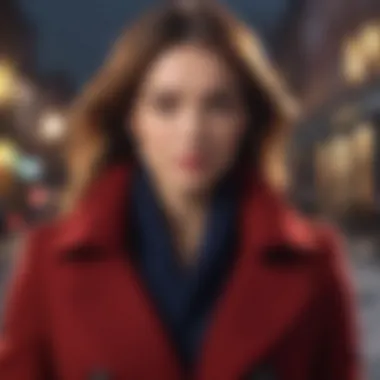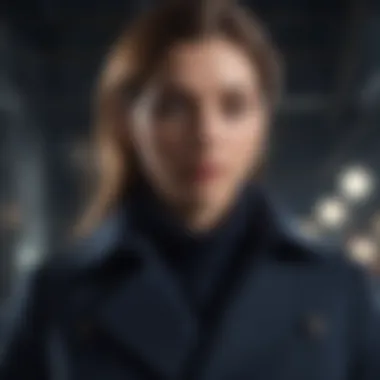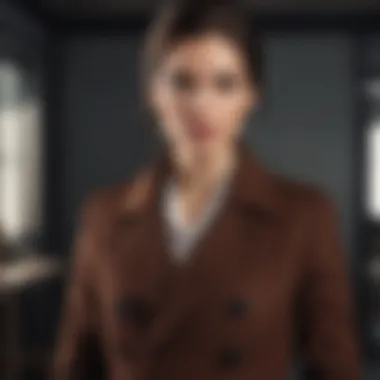Finding the Ideal Women's Peacoat Locally


Intro
Finding the right women's peacoat is more than just a fashion choice; it represents an intersection between personal style and practical needs. A peacoat can add sophistication to a casual outfit or provide warmth during chilly seasons. This guide aims to help readers in their quest for the perfect peacoat nearby, covering everything from styles to shopping options.
Before diving into specific recommendations, it is essential to understand the current fashion landscape. Women today want coats that not only look great but also align with their values, such as sustainability and individuality.
Fashion Trends
Fashion trends in women's peacoats are varied and dynamic. Understanding these trends can assist in making an informed purchase while enhancing one’s wardrobe.
Street Style Inspiration
Street style has transformed how women perceive coats. A well-chosen peacoat can become a statement piece. Current trends suggest mixing and matching colors and patterns to create unique looks with layers. Oversized fits or tailored designs provide versatility, accommodating different body types and personal styles.
Consider how street style icons are wearing their peacoats. For example, pairing a classic navy blue peacoat with distressed jeans and knee-high boots can create a chic, casual look. Alternatively, a fitted peacoat over a flowing dress can strike a balance between structured and soft.
Sustainable Fashion
Sustainability in fashion is a growing concern among consumers. When searching for a peacoat, consider brands committed to ethical production practices. Look for options made from recycled materials or organic fabrics.
Additionally, some brands offer a transparency policy that allows buyers to understand the sourcing and manufacturing processes involved in their clothing. This awareness helps elevate consumer choice, encouraging responsible fashion decisions.
"Choosing sustainable fashion means investing in quality pieces that will last longer and reduce waste."
Choosing the Right Peacoat
When selecting a peacoat, keep in mind the following considerations:
- Fit: The peacoat should complement your body shape. It should not be too tight or too loose.
- Color: Classic colors like navy, black, or gray can be paired easily. Don't shy away from brighter options if that suits your style.
- Material: Wool is commonly used for peacoats, providing warmth. However, synthetic materials may be easier to care for.
In essence, taking the time to research and consider these elements will enhance your shopping experience and ensure satisfaction with your purchase.
Understanding the Women's Peacoat
The women's peacoat stands as a timeless piece in the realm of outerwear. Its significance stretches beyond mere functionality; it embodies history, style, and versatility. Understanding this garment helps in making informed choices when purchasing one. A peacoat is not just about warmth; it's about how the coat complements personal style, occasion, and even body shape.
When one seeks the perfect peacoat, consider the subtle nuances that separate a good coat from a great one. The role of fabric, fit, and fashion trends play a crucial part in this. Familiarity with these factors allows you to select a peacoat that not only serves well in cold weather but also enhances your wardrobe.
Historical Background
Dating back to the 18th century, the peacoat was originally worn by sailors. Made of heavy wool, it offered protection against the harsh elements at sea. Over the years, the design evolved, making its way onto fashion runways and into everyday life. Through various adaptations, the peacoat gained popularity beyond maritime use, becoming a staple in women's fashion.
The traditional double-breasted style features large buttons and a broad collar, both practical and chic. This historical context is vital for understanding the evolution of the peacoat, enabling today's shoppers to appreciate its roots while selecting more contemporary versions.
Current Trends
Today's fashion landscape showcases a variety of peacoats, each offering different interpretations and styles. Current trends lean towards lighter fabrics and diverse colors. There is a noticeable shift from the classic wool to cotton or synthetic blends, driven by both comfort and environmental awareness.
Fashion influencers often exhibit peacoats in unexpected combinations, pairing them with casual wear or even athleisure. These fresh takes on styling have allowed women of various ages to integrate peacoats into their wardrobes year-round, transcending their traditional seasonal use.
Essential Features of a Women's Peacoat
The selection of a women’s peacoat encompasses various essential features that significantly influence its quality and suitability. Understanding these features will enhance your shopping experience, helping you select a coat that meets your functional and aesthetic desires. A well-chosen peacoat can serve as a stylish and versatile addition to your wardrobe, suitable for different occasions. The core elements to consider are fabric types and common styles, both of which determine the look and feel of the coat.
Fabric Types
Wool
Wool is a traditional fabric known for its warmth and durability. It is perhaps the most favored choice for peacoats because of its natural insulating properties. Wool effectively retains heat, making it ideal for colder climates. Additionally, its ability to wick moisture away from the body enhances comfort. The unique feature of wool is its breathability; it allows for air circulation, thus preventing overheating. However, it may require more care, such as dry-cleaning, which can be a consideration for some buyers.


Cotton
Cotton presents another choice for women's peacoats, appreciated for its soft texture and breathability. This fabric is light and comfortable, making it suitable for milder weather. Cotton peacoats often come in various colors and styles, appealing to diverse fashion tastes. One common drawback, however, is that cotton does not provide the same level of warmth as wool, which may limit its wearability in frigid conditions.
Synthetic
Synthetic fabrics are gaining popularity for their practical advantages. These materials often offer water resistance and enhanced durability. A common synthetic choice for peacoats is polyester, which provides a sleek appearance and is often easier to care for compared to natural fibers. While synthetics may fall short in terms of breathability, they significantly contribute to a sporty or modern aesthetic, making them a favorable choice for casual settings.
Blend Materials
Blend materials, combining different fabrics, offer the best of both worlds. A common blend is wool and polyester, which maintains warmth while providing durability and ease of maintenance. This versatility renders blended fabrics an attractive option for many consumers. However, care should be taken to know the percentage of each component, as it influences the peacoat's overall qualities, such as wearability and warmth.
Common Styles
Classic Double-Breasted
The classic double-breasted style remains a timeless choice for many women. Characterized by its two rows of buttons, this design is both functional and stylish. It offers a structured look that fits well for various occasions, from formal to casual outings. One potential downside can be the bulkiness it adds, which may not suit all body types. Nonetheless, it is widely regarded as a staple in women’s outerwear.
Single-Breasted
On the other hand, the single-breasted peacoat provides a sleeker silhouette. This style is defined by a single row of buttons and offers more versatility regarding pairing with different outfits. Its streamlined appearance makes it a popular choice for urban settings. However, in terms of warmth, it may not offer the same coziness as its double-breasted counterpart, especially for those with layering in mind.
Short Length
Short-length peacoats cater to those who prefer a more modern, youthful look. These peacoats typically end around the hip or just above it, making them a fashionable choice for showcasing other elements of your outfit. While this length emphasizes mobility, it can sacrifice some warmth during colder months. Therefore, it is advisable to consider the climate in which you will wear it.
Longer Variants
Longer variants of peacoats are becoming more common, providing additional coverage and warmth. These coats typically extend below the hip, offering a cozy feel for winter weather. A longer coat can also contribute to a more polished appearance, ideal for formal settings. However, the extra material may limit movement and can pose a challenge in navigating crowded environments.
In summary, understanding the essential features of a women’s peacoat, including the fabric types and styles, will significantly aid in selecting a coat that not only meets functional needs but also aligns with personal style preferences.
Where to Find Women's Peacoats Near You
Finding the right women's peacoat requires understanding where to shop. This section focuses on local and online options available to help you discover the ideal peacoat in your area. Shopping locally offers the advantage of trying on different styles and feeling the fabric, while online shopping provides a wider range of choices, often at competitive prices. Understanding these shopping avenues will equip you to make an informed decision.
Local Retailers
Department Stores
Department stores, such as Macy's and Nordstrom, are excellent places to find a variety of women's peacoats. These stores often have a dedicated women's section that features many different brands and styles. The key characteristic of department stores is their ability to offer a wide range of options under one roof. This can be particularly beneficial when searching for a peacoat, as it allows you to compare materials, colors, and fits easily.
One unique feature of department stores is that they frequently carry seasonal items. This means you can find the latest designs, ensuring your choices are trendy. However, one potential drawback is that the selection can vary greatly based on the location of the store and time of year. Additionally, busy stores may mean less personal customer service.
Specialty Boutiques
Specialty boutiques provide a different shopping experience. These shops focus on curated selections of clothing and often carry unique or designer peacoats. The charm of specialty boutiques lies in their exclusivity. They often source items that are not typically found in larger retailers.
Visiting a boutique can lead to discovering a peacoat that truly reflects your personal style. However, the downside is that prices may be higher compared to mass retailers. Remember also that the size range might be more limited, which could impact your options.
Secondhand Shops
Secondhand shops, like Goodwill or local thrift stores, offer a sustainable way to find a women's peacoat. They often have a rotating inventory of garments, including vintage styles. The key characteristic of secondhand shops is their affordability. You can often find peacoats at a fraction of the retail price.
A unique feature of shopping secondhand is the thrill of the hunt; you never know what you might discover. However, the challenge is that the quality and condition of items can vary greatly. It's essential to inspect a peacoat for damages and ensure it fits well.
Online Shopping Options
E-commerce Platforms
E-commerce platforms such as Amazon and Zappos host extensive selections of women's peacoats. These platforms are known for their user-friendly interfaces that allow customers to filter options by size, color, and price. Their wide selection makes them a popular choice for online shopping.


A unique feature of e-commerce platforms is the ability to read customer reviews, which provides insight into the fit and quality of the garment. However, without the chance to try on the coat before purchasing, there is a risk of receiving an item that doesn't meet your expectations. Additionally, shipping fees and return policies can sometimes complicate purchasing decisions.
Brand Websites
Shopping directly from brand websites, like J. Crew or Banana Republic, can yield valuable insights into the latest fashion. These sites showcase their full range of products and often offer exclusive online discounts. The advantage of buying directly is that you know you are getting authentic products.
Brand websites often provide detailed sizing charts to help you find the right fit more accurately. However, a potential downside might be limited styles compared to broader e-commerce sites, which can impact your choice.
Social Media Marketplaces
Social media marketplaces, such as Facebook Marketplace or Instagram shops, have become increasingly popular for fashion finds including women's peacoats. These platforms allow individuals to sell new and gently used items directly to consumers, often at competitive prices.
The key characteristic of social media marketplaces is their localized nature, enabling buyers to find items in their vicinity. This also allows negotiating prices and seeing the item in person before purchasing. However, purchasing from an individual seller carries a degree of risk, as return policies and product quality are not guaranteed. It’s essential to approach these transactions with caution.
Factors to Consider When Choosing a Peacoat
When selecting a women’s peacoat, several factors must be taken into account. These considerations not only ensure comfort and aesthetics but also enhance overall utility and longevity of the garment. Understanding the elements of fit, size, and style preference helps in making more informed decisions. Careful attention to these factors results in a purchase that meets both personal needs and fashion sensibilities.
Fit and Size
Assessing Your Measurements
Assessing your measurements is crucial in finding the right fit for a women’s peacoat. This aspect ensures that the coat does not just look good, but also feels comfortable. It is essential to take accurate measurements of the bust, waist, and hips, alongside shoulder width and sleeve length. A well-fitted peacoat provides better mobility and avoids any discomfort. This kind of specificity helps in selecting the right size and alignment with body shape.
Availability of Different Sizes
The availability of different sizes is another critical factor when choosing a peacoat. Women’s sizes can vary widely among brands, and some might offer petite or plus sizes. Having access to a range of sizes increases the likelihood of finding a coat that fits well. This inclusivity addresses the diverse shapes and sizes that women have, making it a vital aspect of the shopping process. Keep in mind that different retailers may carry varying size options.
Importance of Tailoring
The importance of tailoring cannot be overlooked in the purchasing process of a women's peacoat. Even if a coat fits well off the rack, minor adjustments can enhance its fit significantly. Tailoring can adjust the length of sleeves, cinch the waist, or even fit the shoulders. A tailored peacoat transforms a standard purchase into a personalized piece. This customization allows for comfort and style that match the wearer's body type, making it a worthwhile investment.
Color and Style Preference
Classic Colors vs. Modern Palettes
When it comes to color, the choice between classic colors and modern palettes can greatly influence the appeal of a peacoat. Classic colors, such as navy, black, and gray, tend to remain timeless and versatile. They can easily match various outfits, ensuring the coat can be worn on multiple occasions. In contrast, modern palettes include brighter or unique shades that might reflect current trends. This aspect introduces a sense of contemporary style but might not have the same longevity as classic hues.
Suitability to Personal Style
The suitability of the peacoat to personal style is a vital element in the selection process. Each individual has a distinct style, whether it leans towards minimalism, bohemian, or chic sophistication. Finding a peacoat that resonates with personal expression ensures that the wearer feels confident and comfortable. This connection between style and individual identity provides a deeper satisfaction with the garment chosen.
Complementing Wardrobe
Finally, complementing the wardrobe is essential when evaluating a peacoat. A well-chosen coat should seamlessly blend with existing clothing and accessories. This includes checking how the peacoat coordinates with colors, patterns, and overall attire. It is beneficial to consider how versatile the coat is with different outfits, ensuring optimal use.
"A well-fitted peacoat enhances both the style and comfort of the wearer, making it a crucial element in any winter wardrobe."
By taking these factors into account, you can make a more informed choice in selecting a women's peacoat that suits your needs and preferences.
Sustainability in Fashion Choices
In the context of modern fashion, sustainability has emerged as a crucial factor. The awareness of environmental impacts calls for conscious choices that benefit both people and the planet. This article discusses the significance of sustainable options in finding a women's peacoat. Making informed decisions about style and material not only enhances personal fashion choices but also contributes to broader ecological welfare. Choosing sustainable options can offer several benefits, including reduced waste and support for ethical practices.
By exploring sustainable fashion features like eco-friendly fabrics and fair trade production, one can opt for items that resonate with personal values and social responsibility. Such decisions often mean prioritizing quality over quantity, resulting in more durable garments that promote a longer lifecycle.
Eco-Friendly Fabrics
Organic Materials
Organic materials are those produced without synthetic fertilizers or pesticides. This aspect makes them a viable choice for eco-conscious consumers. One key characteristic of organic materials is their lower environmental footprint. They generally require less water and energy to produce. This can be a significant benefit as water scarcity issues are crucial globally.


Moreover, organic cotton and wool also tend to be softer, which enhances comfort. However, the downside is their often higher price point, which may deter some buyers. When considering craftsmanship, organic materials provide an important option for those who want to blend style with environmental ethics.
Recycled Fabrics
Recycled fabrics utilize waste materials to create new textiles. This approach significantly reduces textile waste in landfills. A core characteristic of recycled fabrics is their contribution to a circular economy, promoting sustainability in fabric production. Their use can play a vital role in minimizing resource depletion, making clothing more environmentally friendly.
The unique feature of recycled materials often comes with the challenge of maintaining the same quality as virgin fabrics. While innovations are improving this aspect, buyers may still notice a difference in texture or durability. Nonetheless, choosing recycled fabrics showcases a commitment to reducing environmental impact while supporting the innovative aspects of modern fabric production.
Ethical Production Practices
Fair Trade Brands
Fair trade brands prioritize equitable trade relations, ensuring workers receive fair compensation for their labor. This characteristic not only advocates for workers' rights but also guarantees quality production standards. Hence, purchasing from fair trade brands is not simply a fashion choice; it supports ethical dimensions of fashion.
The uniqueness of fair trade brands lies in their transparency and commitment to social responsibility. However, while prices may be higher compared to fast fashion, the benefits often justify the investment when one considers the ethical implications involved.
Local Artisans
Supporting local artisans injects life into communities and promotes local economies. The work of local artisans is often characterized by craftsmanship, which can provide unique and high-quality garments. Investing in pieces made by local artisans helps to maintain traditional skills and contribute to community sustainability.
Nevertheless, the key challenge is accessibility, as not all areas may have artisans readily available. Prices may also vary based on the intricacy of the work. Nonetheless, choosing to buy from local artisans reveals a commitment to unique fashion while fostering community spirit.
Caring for Your Peacoat
Caring for your peacoat is crucial for maintaining its look and longevity. A peacoat is an investment piece in any woman's wardrobe, often blending style with function. Proper care ensures that it remains a staple in your collection, ready to be worn season after season. This section addresses cleaning, maintenance, and storage tips, providing a comprehensive understanding of how to care for women's peacoats.
Cleaning and Maintenance
Dry Cleaning Procedures
Dry cleaning is a popular method for maintaining the appearance of your peacoat. The process involves the use of solvents rather than water to clean the fabric. This is particularly important for materials like wool, which can shrink or lose shape when exposed to water. One key characteristic of dry cleaning is its ability to remove stains without damaging delicate fibers.
Many women choose dry cleaning because it is effective and can preserve the coat's structure and color. However, it can be costly if done frequently. An additional factor to consider is the potential use of harsh chemicals in some dry cleaning processes, which might affect the fabric's longevity.
Home Washing Techniques
Alternatively, home washing can be a quicker and more economical choice for maintaining your peacoat. Depending on the fabric and the care label instructions, some peacoats may be machine washable. A key characteristic of this method is its convenience. You can wash your coat at your own pace and avoid the time needed to go to a dry cleaner.
However, caution is essential. The unique feature of home washing is that it allows for gentle cycles and cool temperatures to minimize damage. While this method saves money and time, improper washing techniques can lead to fading or distortion of the coat. Be sure to follow care labels to avoid damaging your garment.
Storage Tips
Proper Hanging Methods
Proper hanging methods help maintain the shape of your peacoat when it's not being worn. Using a sturdy hanger that matches your coat's width ensures it hangs correctly without losing its form. This method is beneficial as it reduces the risk of creases and maintains the silhouette.
The advantage of hanging is that it allows for air circulation, which helps prevent odors and mold. However, avoid overcrowding the closet, as this can lead to pressing against other garments, causing unwanted creases.
Seasonal Storage Solutions
Seasonal storage solutions are also important, especially if you live in an area with temperature fluctuations. When the weather turns warmer, properly storing your peacoat helps safeguard it from damage. You might consider using breathable garment bags or cotton covers to protect it from dust and insects.
A key characteristic of seasonal storage is the ability to maintain fabric integrity. Keeping your coat in a suitable environment prevents fading and ensures fibers remain intact. However, ensure to fold it properly without excessive pressure, as this can cause fabric to weaken over time.
In summary, understanding how to care for your peacoat is essential for preserving its quality and extending its lifespan. By following proper cleaning techniques and effective storage methods, you can ensure that your investment remains a stylish addition to your wardrobe for years to come.
Closure
In navigating the world of women's peacoats, the concluding remarks provide a crucial summary of the key elements discussed throughout the article. Understanding how to select the right peacoat extends well beyond mere aesthetics; it encompasses various layers of decision-making that align with personal style, fit, and sustainable practices. This understanding ensures that one does not simply purchase a coat, but rather makes a mindful investment into their wardrobe.
A well-selected peacoat can serve multiple purposes. It is designed to offer warmth, style, and a statement of individual fashion preferences. Therefore, knowing the importance of fabric types and styles provides the foundation for a thoughtful choice. Furthermore, considering factors such as fit, color, and ethical production practices adds depth to this significant fashion decision.
Final Thoughts
In sum, finding the perfect women's peacoat involves a multifaceted process. Start by evaluating personal style and requirements, then explore different retailers and options, both locally and online. It’s important to remember that the journey to owning a timeless piece should involve considerations of sustainability and ethical practices.
When one takes the time to understand the nuances of this garment, including its history and current trends, the selection process becomes more fulfilling. Ultimately, a well-chosen peacoat is not just a functional outerwear but a reflection of individual identity and values.



